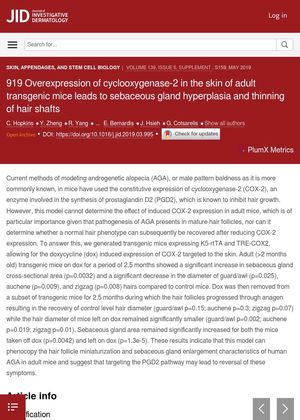Overexpression of Cyclooxygenase-2 in the Skin of Adult Transgenic Mice Leads to Sebaceous Gland Hyperplasia and Thinning of Hair Shafts
April 2019
in “
Journal of Investigative Dermatology
”

TLDR Increasing COX-2 in mouse skin causes bigger sebaceous glands and thinner hair, but stopping COX-2 can reverse hair thinning.
In 2019, a study was conducted to understand the effects of induced cyclooxygenase-2 (COX-2) expression in adult mice, a model for androgenetic alopecia (AGA), or male pattern baldness. The researchers generated transgenic mice expressing K5-rtTA and TRE-COX2, which allowed for the doxycycline (dox) induced expression of COX-2 targeted to the skin. Adult transgenic mice on dox for 2.5 months showed a significant increase in sebaceous gland cross-sectional area and a significant decrease in the diameter of various types of hairs compared to control mice. When dox was removed from a subset of transgenic mice for 2.5 months, the hair follicles recovered to control level hair diameter, while the hair diameter of mice left on dox remained significantly smaller. Sebaceous gland area remained significantly increased for both the mice taken off dox and left on dox. The results suggested that this model could mimic the hair follicle miniaturization and sebaceous gland enlargement characteristics of human AGA in adult mice, and that targeting the PGD2 pathway may lead to reversal of these symptoms.




